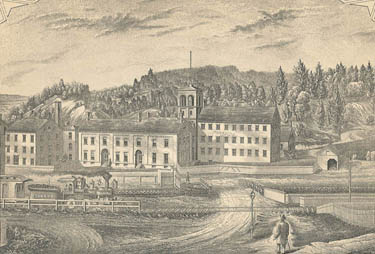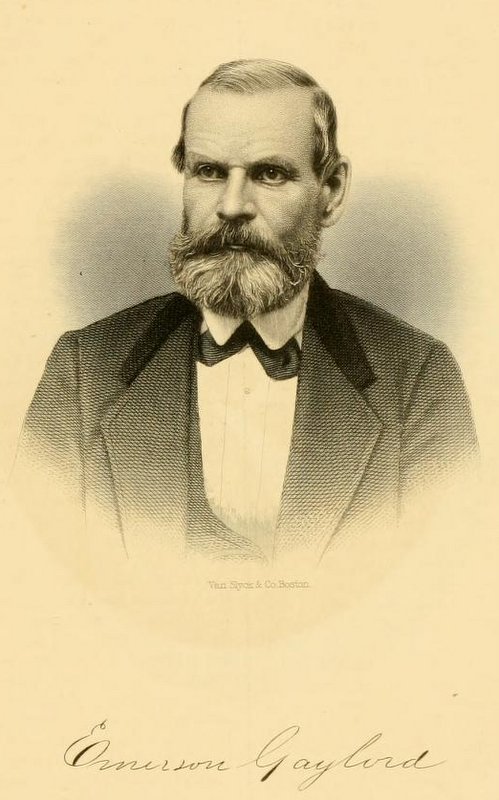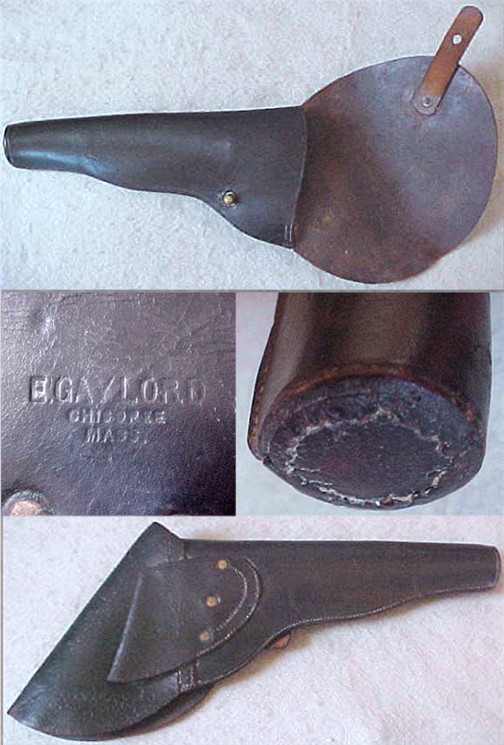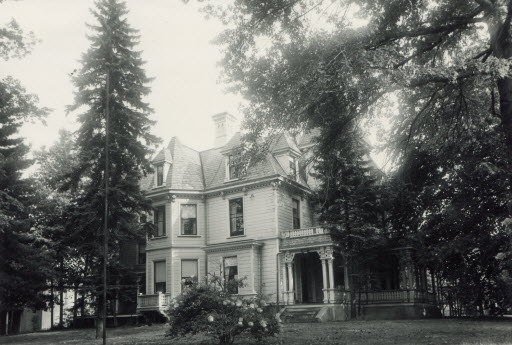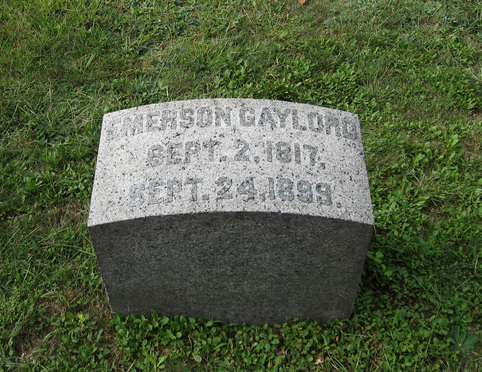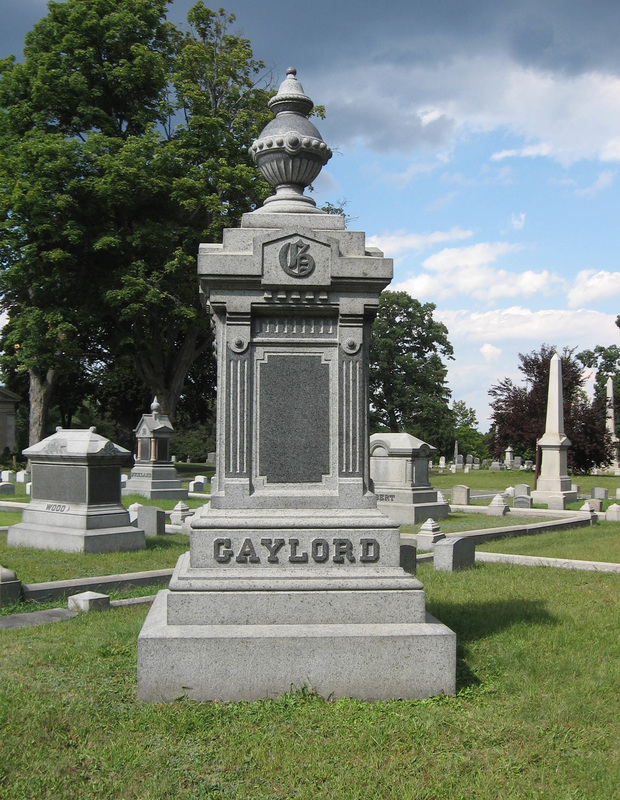Emerson Gaylord
As a young man Emerson Gaylord apprenticed himself to first a harness maker and then to shoe makers learning their trades. In 1841 he went to Chicopee, Massachusetts and to work for the N. P. Ames Company, manufacturers of cannon, swords, and military accoutrements.
Emerson Gaylord was the son of Josiah and Lucinda Smith Gaylord. He was born in South Hadley, Massachusetts on Sept. 2, 1817. His father died in 1826 when Emerson was 9 years old and when he was 12 he left school to support himself on the neighboring farms. At the age of 17, he was apprenticed to Seth Nyms, of Amherst, to learn the harness-making business. He soon found that he was obliged to do too much work on his employer's farm, and being ambitious, he remained there but two months, when he returned to South Hadley and began to learn the shoemaker's trade under George Kilbourn. After leaving the employ of Kilbourn, he worked in the shoe business for his cousin John Gaylord until 1840. With $40 in savings, he left the business in, accepting an offer of employment in Chicopee with the N.P. Ames Company, manufacturers of cannon, swords, and military accoutrements, including artillery harness and saddles.
In 1841, Nathan Peabody Ames of the Ames Manufacturing Co. had secured a lucrative contract with the fledgling Republic of Texas. The Ames Co. made cannon, swords and military accoutrements, including artillery - harness and saddles.Gaylord joined the company's leather operation at a modest 70 cents a day. In less than a month, the company doubled his pay. The Texas trade was pivotal to the company's growth. By 1843, the company was supplying the Texans with swords, firearms and cannon. For Texas, the little leather division was now producing a full line of military scabbards, heavy-duty harnesses and saddles. When the health of the foreman failed in 1843, the 26-year-old was put in charge of the shop.
By 1844, the little company on the Chicopee River was making heavy ordnance for the United States Army. Several hundred employees were making cannon and swords for immediate delivery. The administration of James K. Polk was on the brink of war with the Republic of Mexico. The brothers Nathan and James Tyler Ames were busy with the lucrative government ordnance work. It was then that Emerson Gaylord informed the brothers he wished to terminate his employment with the company. Instead, he entered into a contract as a supplier of leather goods to the company. He assumed the cost of raw materials, all production expenses and employee wages. He was paid a set amount for each unit.
Gaylord continued in this business until 1 January 1856, when he purchased outright the leather division of the Ames Company and added the manufacture of leather fire hoses and machine belting. In 1856 he received orders from the War Department for military accoutrements, and continued to fill orders from that department every three months up to 1861. During this time he furnished accoutrements for several southern states, including Maryland, Virginia, Georgia, Alabama and Mississippi.
On the day that Fort Sumter fell, Mr. Gaylord had a large stock of accoutrements for the south on hand, and on the afternoon of the same day received a dispatch from Col. Thornton, Commanding at Governor's Island, New York., to ship to the government all goods on hand and in process of construction. Soon after a messenger arrived from Governor Andrew with the same request for Massachusetts. He resolved to divide them equally between the government and the state, and did so.
But before night of that same day a noted speculator from New York arrived and offered Gaylord ten thousand dollars more than he would otherwise receive for that same stock of accoutrements. Gaylord knowing if this man controlled the goods he would sell to the southern states, promptly refused the offer, preferring to aid the federal government in this crisis, no matter how great the cost to himself.
The demand from the federal government for this line of goods continued to become larger, and to fill his orders he erected large buildings and increased his working force to four hundred and fifty men, shipping from eighteen to twenty thousand dollars worth of goods each week. In 1861 he also contracted with the government to furnish the leather mail-bags for a term of four years, and the contract was continued until he had held it twelve years. In April 1863, Mr. Gaylord organized a stock company, of which he was elected president, and in which he owned a majority of the stock
Emerson Gaylord was the son of Josiah and Lucinda Smith Gaylord. He was born in South Hadley, Massachusetts on Sept. 2, 1817. His father died in 1826 when Emerson was 9 years old and when he was 12 he left school to support himself on the neighboring farms. At the age of 17, he was apprenticed to Seth Nyms, of Amherst, to learn the harness-making business. He soon found that he was obliged to do too much work on his employer's farm, and being ambitious, he remained there but two months, when he returned to South Hadley and began to learn the shoemaker's trade under George Kilbourn. After leaving the employ of Kilbourn, he worked in the shoe business for his cousin John Gaylord until 1840. With $40 in savings, he left the business in, accepting an offer of employment in Chicopee with the N.P. Ames Company, manufacturers of cannon, swords, and military accoutrements, including artillery harness and saddles.
In 1841, Nathan Peabody Ames of the Ames Manufacturing Co. had secured a lucrative contract with the fledgling Republic of Texas. The Ames Co. made cannon, swords and military accoutrements, including artillery - harness and saddles.Gaylord joined the company's leather operation at a modest 70 cents a day. In less than a month, the company doubled his pay. The Texas trade was pivotal to the company's growth. By 1843, the company was supplying the Texans with swords, firearms and cannon. For Texas, the little leather division was now producing a full line of military scabbards, heavy-duty harnesses and saddles. When the health of the foreman failed in 1843, the 26-year-old was put in charge of the shop.
By 1844, the little company on the Chicopee River was making heavy ordnance for the United States Army. Several hundred employees were making cannon and swords for immediate delivery. The administration of James K. Polk was on the brink of war with the Republic of Mexico. The brothers Nathan and James Tyler Ames were busy with the lucrative government ordnance work. It was then that Emerson Gaylord informed the brothers he wished to terminate his employment with the company. Instead, he entered into a contract as a supplier of leather goods to the company. He assumed the cost of raw materials, all production expenses and employee wages. He was paid a set amount for each unit.
Gaylord continued in this business until 1 January 1856, when he purchased outright the leather division of the Ames Company and added the manufacture of leather fire hoses and machine belting. In 1856 he received orders from the War Department for military accoutrements, and continued to fill orders from that department every three months up to 1861. During this time he furnished accoutrements for several southern states, including Maryland, Virginia, Georgia, Alabama and Mississippi.
On the day that Fort Sumter fell, Mr. Gaylord had a large stock of accoutrements for the south on hand, and on the afternoon of the same day received a dispatch from Col. Thornton, Commanding at Governor's Island, New York., to ship to the government all goods on hand and in process of construction. Soon after a messenger arrived from Governor Andrew with the same request for Massachusetts. He resolved to divide them equally between the government and the state, and did so.
But before night of that same day a noted speculator from New York arrived and offered Gaylord ten thousand dollars more than he would otherwise receive for that same stock of accoutrements. Gaylord knowing if this man controlled the goods he would sell to the southern states, promptly refused the offer, preferring to aid the federal government in this crisis, no matter how great the cost to himself.
The demand from the federal government for this line of goods continued to become larger, and to fill his orders he erected large buildings and increased his working force to four hundred and fifty men, shipping from eighteen to twenty thousand dollars worth of goods each week. In 1861 he also contracted with the government to furnish the leather mail-bags for a term of four years, and the contract was continued until he had held it twelve years. In April 1863, Mr. Gaylord organized a stock company, of which he was elected president, and in which he owned a majority of the stock
Private Life
When Gaylord came to Chicopee, he joined the Third Congregational Church on Springfield Street. He immediately impressed the congregation and in 1844 when he purchased the leather division of the Ames Manufacturing Company it was several parish members who helped finance his new venture. That same year he married Jane Burnett, a native of South Hadley. They would have one son named Arthur together.
During the Civil War, the leather division he purchased from the Ames Company prospered, while profits in the heavy ordinance division the Ames Company kept never lived up to expectations. Almost overnight, Emerson Gaylord was Chicopee's wealthiest citizen, the town's leading business and community leader, the organizer of two banks, a leading real estate developer and major investor in a dozen local manufacturing concerns.
In 1856 Gaylord purchased purchase a house at the corner of Springfield Street and Fairview Avenue in Chickopee, Massachusetts from H.H. Phetteplace. By the 1870s, he owned the entire block and had demolished the original structure. Here at 199 Springfield Street he built the largest home in Chicopee and it became known as the Gaylord Mansion. His neighbors included Gov. George Dexter, who lived at 104 Springfield St., and United States Attorney George Stearns, whose home was at 111 Springfield St. These mean along with many of the business and political leaders of the day were entertained in Gaylord's home which became a favorite gathering place for them.
In politics Mr. Gaylord was a republican, and active in the work of this party. he was a member of the legislature in 1866. From 1875 until his death on Sep. 24, 1899 he was president of the First National Bank of Chicopee and a member of the Third Congregational Society of Chicopee.
In 1962, Elms College purchased the Gaylord Mansion for $50,000. In 1997, an Elms College Cornerstone Campaign raised $100,000 to refurbish the exterior of the historical structure. The structure is described as being French Second Empire Style. Today the restored Gaylord Mansion is the Elm's College's faculty center.
("Genealogies and Personal Memoirs Relating to the Families of the State of Massachusetts")
Ancestry.com. North America, Family Histories, 1500-2000 [database on-line]. Provo, UT, USA:
http://www.findagrave.com/cgi-bin/fg.cgi?page=gr&GRid=96419080
Stephen Jendrysik | Special to The Republican
on July 10, 2013 at 5:30 AM, updated July 10, 2013 at 5:31 AM at http://www.masslive.com/living/index.ssf/2013/07/stephen_jendrysik_mansion_was_home_to_emerson_gaylord_chicopees_main_man_in_19th_century.html
When Gaylord came to Chicopee, he joined the Third Congregational Church on Springfield Street. He immediately impressed the congregation and in 1844 when he purchased the leather division of the Ames Manufacturing Company it was several parish members who helped finance his new venture. That same year he married Jane Burnett, a native of South Hadley. They would have one son named Arthur together.
During the Civil War, the leather division he purchased from the Ames Company prospered, while profits in the heavy ordinance division the Ames Company kept never lived up to expectations. Almost overnight, Emerson Gaylord was Chicopee's wealthiest citizen, the town's leading business and community leader, the organizer of two banks, a leading real estate developer and major investor in a dozen local manufacturing concerns.
In 1856 Gaylord purchased purchase a house at the corner of Springfield Street and Fairview Avenue in Chickopee, Massachusetts from H.H. Phetteplace. By the 1870s, he owned the entire block and had demolished the original structure. Here at 199 Springfield Street he built the largest home in Chicopee and it became known as the Gaylord Mansion. His neighbors included Gov. George Dexter, who lived at 104 Springfield St., and United States Attorney George Stearns, whose home was at 111 Springfield St. These mean along with many of the business and political leaders of the day were entertained in Gaylord's home which became a favorite gathering place for them.
In politics Mr. Gaylord was a republican, and active in the work of this party. he was a member of the legislature in 1866. From 1875 until his death on Sep. 24, 1899 he was president of the First National Bank of Chicopee and a member of the Third Congregational Society of Chicopee.
In 1962, Elms College purchased the Gaylord Mansion for $50,000. In 1997, an Elms College Cornerstone Campaign raised $100,000 to refurbish the exterior of the historical structure. The structure is described as being French Second Empire Style. Today the restored Gaylord Mansion is the Elm's College's faculty center.
("Genealogies and Personal Memoirs Relating to the Families of the State of Massachusetts")
Ancestry.com. North America, Family Histories, 1500-2000 [database on-line]. Provo, UT, USA:
http://www.findagrave.com/cgi-bin/fg.cgi?page=gr&GRid=96419080
Stephen Jendrysik | Special to The Republican
on July 10, 2013 at 5:30 AM, updated July 10, 2013 at 5:31 AM at http://www.masslive.com/living/index.ssf/2013/07/stephen_jendrysik_mansion_was_home_to_emerson_gaylord_chicopees_main_man_in_19th_century.html

